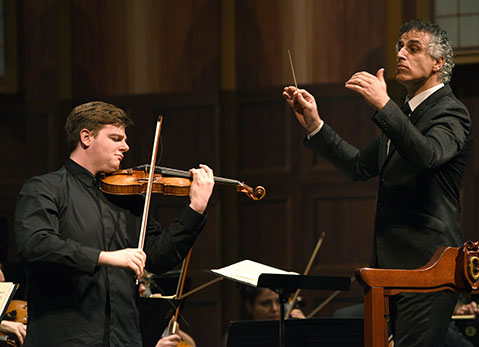Review: Santa Barbara Symphony at the Granada Theatre
Violinist Chad Hoopes Gave Audiences an Impression of Spain

Cultures can be experienced and assessed directly, yet sometimes a more revealing approach is to listen for echoes from the outside. Sure, you will find caricatures and distortions, but you might also find a wisely naïve discernment of spirit. Santa Barbara Symphony’s program Impressions of Spain accordingly was weighted toward the aroma of Spain from nonnative sources: the Romantic imaginations of Frenchmen Édouard Lalo (1823-1892) and Jules Massenet (1842-1912) and Russian composer Nikolai Rimsky-Korsakov (1844-1908). The sole truly Spanish representative was Manuel de Falla (1876-1946). Oh, and fortunately nothing from Bizet’s Carmen (beloved, but overplayed). It was an evening of big orchestration: versatile strings chiseled by the sharp, syncopated accents from a formidable brass line; piccolo-tinged woodwind swirls that rolled like a flamenco skirt; and, of course, tambourine and castanets — signature percussion of Spanish folk music. Programmatic accents included dancing by flamenco artist Laura Dubroca and a truly impressive S.B. Symphony debut by 20-year-old violin soloist Chad Hoopes. Hoopes, a rising star, has already released a recording of works by Mendelssohn and John Adams with the Leipzig Radio Symphony and is soon to be the first artist-in-residence with the Munich Symphony Orchestra.
Hoopes’s presence itself was something of a small miracle (and testimony to the Symphony’s smart networking); he was a last-minute replacement for scheduled performer Elissa Lee Koljonen, who was forced to withdraw because of injury. The American violinist wore the pressure well. Stepping forward at opening curtain to a sizzling performance of Lalo’s signature violin concerto Symphonie espagnole. Hoopes’s phrasing, tone choices, and dynamics expressed superb freedom and an improvised feeling. The third movement, Intermezzo, had the violinist repeating phrases in a dialogue with himself, and Hoopes’s alternation between a sweet introspection and a digging angst was a thrilling contrast of color. The lightening-fast runs in the concluding Rondo were only surpassed, perhaps, by a clearly visible sense of fun.
The second half of the program opened with a suite of seven delightful short ballet themes from Massenet’s Le Cid, inspired by traditional Spanish regional dances. Next came the swaying rhythms of the Interlude and Dance from Manuel de Falla’s short opera La vida breve, with movement visually boosted by Dubroca, in bright blue satin costume. Dubroca displayed expert rhythmic finesse with her thick-soled taps (just audible against the orchestral percussion) and castanet playing. It was a smart move for the S.B. Symphony to reach out to area flamenco talent for this one. Put together the Spanish theme with the Granada Theatre and a large pool of off-season Fiesta performers — it would have been a sin not to.
Finally, the concert turned to a contrasting take on the music of Spain, one of Rimsky-Korsakov’s best-known orchestral works, Capriccio espagnol. Composed during a retreat on the shores of Lake Nelai, the piece is as much Russian melancholy as Spanish inspiration. But the work also featured talented section soloists in woodwinds and strings, with some especially fine playing by concertmaster Elizabeth Hedman. An encore of Falla’s Ritual Fire Dance brought Dubroca back to the stage, all aflame in red.



